Neyland is situated on the northern bank of the River Cleddau, in Pembrokeshire, and was founded after the opening of the South Wales Railway in 1856. The town is associated with its fine situation at the crossing over the Cleddau, and boasts a thriving trade centred around its Marina, and boat related trades. Haverfordwest is just 10 miles away, and Milford Haven and Pembroke Dock are also within easy reach. Numerous men from Neyland served in all branches of the armed forces during the First World War and a memorial to the fallen was unveiled in December 1930, and is sited at the top of Riverside Avenue, overlooking Pembroke Dock in the distance.
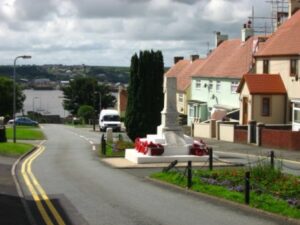
The Great War, 1914-1918
George Henry Archer, Battery Sergeant Major, 25269, Royal Garrison Artillery. George was born on 13 April 1888, the son of John Henry and Elizabeth Archer, of Gillingham, Kent. George served with the army prior to the war, and was based in Pembrokeshire prior to the war. He married Elizabeth Broad Hansford at Milford in 1913, and the couple set up home at 23, Fredrick Street, Neyland, where their daughter Ethel was born. George landed in France on 2 June 1916, with 147th Siege Battery, Royal Garrison Artillery. George fought throughout the Somme Offensive, quickly rising from Sergeant to Battery Sergeant Major. He was killed at Arras on 7 July 1917, aged 30, and is buried at Barlin Communal Cemetery Extension, France.
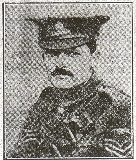
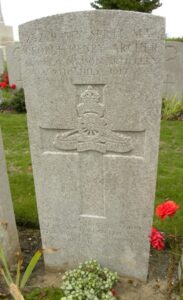
Thomas Henry Banner, MID, Sergeant, 14242, Royal Engineers. Thomas was the son of Thomas and Annie Banner, of Sea View, Llanstadwell, and had enlisted at Devonport into the Royal Engineers. He was posted to their 2nd Field Company, which was attached to the 8th Division. The 8th Division was formed during October 1914, by the bringing together of regular army units from various points around the British Empire. The Division moved to the Western Front in November 1914, a badly-needed reinforcement to the BEF which had been all but wiped out at Ypres. They saw their first major action at the Battle of Neuve Chapelle, and then at the Battle of Aubers. They then saw further fighting at the Action of Bois Grenier, before moving to the Somme in 1916, where they fought at the Battle of Albert. In March, 1917 they followed the German Retreat to the Hindenburg Line, which is probably where Thomas was Mentioned in Despatches (Gazetted on 18 May 1917). Later that year the Division moved to Ypres, fighting at the Battle of Pilckem, and the Battle of Langemarck. In March 1918 the Division were on the southern end of the Somme, and here met the German Offensive head on, at the Battle of St Quentin. They were pushed back, fighting at the Actions at the Somme Crossings, the Battle of Rosieres, and the Actions of Villers-Bretonneux, before being withdrawn from the line to rest. However, the chosen rest area was soon to be hit by a German attack on their new positions on the Aisne, and fought at the Battle of the Aisne. Thomas was killed here on 27 May 1918. He was 38 years old, and is commemorated on the Soissons Memorial, France.
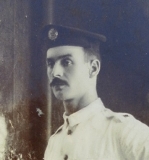
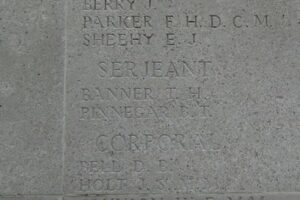
John Bryan Bermingham, Engine Room Artificer 4th Class, M/12333, Royal Navy. John was born on 14 July 1893, the son of Michael Bermingham and Annie Priscilla Bermingham (nee Morris), of 27, Kensington Road, Neyland. He worked as a fitter prior to enlisting into the Royal Navy on 2 March 1915 and after completing his training at HMS Victory II was posted aboard the Duke of Edinburgh Class Cruiser, HMS Black Prince. The Black Prince was attached to the First Cruiser Squadron during the Battle of Jutland, on 31 May 1916. She had become separated from the rest of the fleet when she was spotted by the German Battleship Thuringen, who trained her searchlights onto her, making her a sitting target for the rest of the German fleet. After a desperate 15 minute fight against the odds, the Black Prince blew apart and sank. John was 22 years old when he was killed during the loss of Black Prince. He has no known grave but the sea, so is commemorated on the Portsmouth Naval Memorial, Hampshire.
James Ethelbert Berry, Private, 1794, Berkshire Yeomanry. James was the son of James William and Elizabeth Berry, of Marine Villa, Neyland. He worked as a machinist at a railway signal works at Reading prior to the war, and he enlisted at Reading into the Berkshire Yeomanry. The Regiment formed part of the 2nd South Midland Mounted Brigade, 2nd Mounted Division and moved to Gallipoli during August 1915. James was killed during the attack on Hill 60 on 21 August 1915. He was just 21 years old, and is commemorated on the Helles Memorial, Gallipoli. James is not commemorated locally.
Ernest Sidney Blackmore, Private, 71225, Royal Army Medical Corps. Ernest was the son of Walter John and Agnes Blackmore, of 16, Frederick Street, Neyland. Ernest originally served with the 124th Field Company, Royal Engineers, which was attached to the 38th (Welsh) Division. He transferred to No. 1 Company, Royal Army Medical Corps in September 1915, and served on HMHS Aquitania (a Hospital Ship) from 8 October 1915 until 4 December 1915, when he was hospitalised at Alexandria, suffering from enteric fever, and spent four months recovering before being invalided to England aboard the SS Dover Castle. Ernest survived the war, bad sadly became one of the many influenza casualties which marked the end of the conflict. He died at Aldershot Isolation Hospital on 22 November 1918, aged 23, and is buried at Honeyborough Cemetery, Neyland.
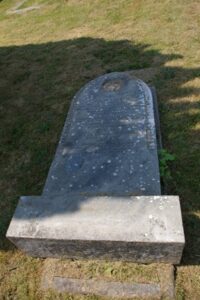
Richard James Brown, Private, 536622, London Regiment. Richard was born at Customs House, London in 1894, the son of Richard and Caroline Jane Brown. The family resided at 18, High Street, Neyland prior to the war. Richard enlisted at Cardiff into the Army and joined the 15th Battalion (Prince of Wales Own Civil Service Rifles), London Regiment, which was part of 140 Brigade, 47th (2nd London) Division. The Division moved to France during March 1915, and served on the Western Front throughout the war. The new designation of the Division, its Brigades and other constituent units changed from the 2nd London to 47th in mid May 1915. The Division fought at the Battle of Aubers, and the Battle of Festubert during May 1915 and in September fought at the Battle of Loos, and subsequent Action of Hohenzollern Redoubt. They were north of Arras when the Germans attacked Vimy Ridge, and then moved south to the Somme, where they fought at the Battle of Flers-Courcelette, and then at the Battle of Le Transloy, where the Division captured Eaucourt l’Abbe, and took part in Attacks on the Butte de Warlencourt. Early in 1917 the Division moved north to Belgium, and took part in the Battle of Messines, and then in November, 1917 fought at the Battle of Cambrai. Richard was killed at Cambrai on 6 December 1917, aged 23. Richard is commemorated on the Cambrai Memorial, Louverval, France.
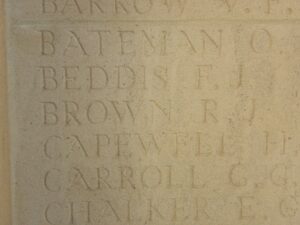
Charles Augustus Button, Second Lieutenant, Royal Field Artillery. Charles was born at Llanstadwell on 27 March 1884, the son of John and Elizabeth Button (nee Waters). By 1901 Charles is recorded as lodging at 23, Railway Terrace, Resolven, where he worked as a Railway Clerk for the GWR. At some time prior to the war, Charles had moved to London, residing at 40 Gordon Avenue, St Margarets (near Twickenham) in 1911, where he worked as a Bank Clerk. Here he played rugby for the local team, Rosslyn Park. Charles enlisted at Twickenham into the Honorable Artillery Company, serving as a Bombardier, service number 624077. He arrived in France on 13 March 1917, where he was commissioned Second Lieutenant into the Royal Field Artillery, and was posted to their 45th Brigade, which had been in France since 1914 attached to the 8th Division. By the beginning of 1918 Charles was a section Commander in 5th Battery, 45th Brigade, RFA, and saw heavy fighting on the Somme in March and April 1918, during the German Spring Offensive. The battered Division was then moved southwards, to the Aisne, where it was intended for it to rest and rebuild strength. However, the Germans launched a fresh offensive on the Aisne during May 1918, and Charles’ Battery were caught up in terrible fighting again, during the Battle of Bois de Buttes on 27 May 1918. Facing a numerically superior enemy force, the 8th Division suffered a large amount of casualties that day, with Charles’ 5th Battery putting up a stout resistance throughout the night until, at about 6.30am the enemy appeared on the battery position. Many guns, however, had been put out of action by direct hits before being overhauled. Charles himself was killed just after destroying important maps and documents, and was last seen lying dead in the trenches. He was awarded the French Croix-de-Guerre for his bravery, and is commemorated on the Soissons Memorial to the missing. His medals were sent to his brother M. E. Button, at 4, Great Eastern House, Neyland, Pembrokeshire. Many thanks to his Great Nephew, James Button, for the extra information, and the photograph of Charles.
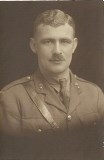
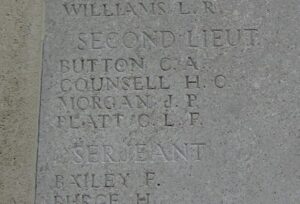
Thomas Isaac Charles, Engineman, 2716/ES, Royal Naval Reserve. Thomas was born at Neyland in 1887, the son of Thomas and Mary Charles. He was a fisherman prior to the war, and lived with his wife, Mary Ann Charles, at 8, Church Lake Terrace, Neyland. He served aboard the Trawler Dragoon, which was a 30 ton smack. On 20 August 1916 the Dragoon was captured by the German submarine UC10, who sank it by means of a bomb, about 36 miles North-East of Gromer. Thomas survived, probably being taken prisoner, but was sent home when he was taken ill, and died on 29 November 1917, aged 30. He is buried at Honeyborough Cemetery, Neyland.
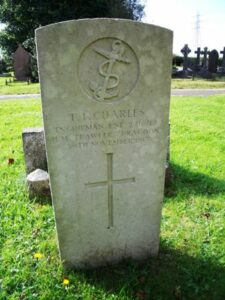
Albert Osman Cole, Sapper, 82555, Royal Engineers. Albert was born in Neyland on 13 April 1882, the son of Richard and Alice Cole. He worked as a Telegraphist for the GWR prior to the war, and had served with the Royal Monmouth Royal Engineers Militia from 28 March 1905 until being discharged for misconduct on 2 November 1907. He was a widower when he married Sarah Williams at Pontypridd in 1915. (She later remarried, and lived at 3, New Chapel Street, Treorchy). He re-enlisted at Maesteg into the Royal Engineers, and joined their 34th Signal Company, at Fenny Stratford. The Company was attached to the 34th Division, which moved to France between 7 and 15 January 1916, and saw its first major action on the Somme, during the Battle of Albert, where it suffered very severe casualties during its part in the attack on La Boisselle. It then took part in the Battle of Bazentin, Battle of Pozieres and the Battle of Flers-Courcelette. Albert was wounded on the Somme, and brought back to Hospital in Birmingham for treatment. Sadly he died of his wounds on 27 October 1916 and is buried at Birmingham (Lodge Hill) Cemetery. Albert is not commemorated locally.
Thomas George Davies, Engineman, 1620/ES, Royal Naval Reserve. Thomas was born at Neyland on 26 March 1876, the son of Benjamin and Eleanor Davies. He resided with his wife, Alice Maud Davies, at 7, Bellevue Terrace, Neyland prior to the war. Thomas served aboard His Majesty’s Trawler Othonna as an Engineman. The Othonna was sunk when she struck a mine off Fife Ness on 20 April 1917 which had been laid by UC41 just a day earlier. All hands were drowned, but some of the men’s bodies were washed ashore, and so afforded burial. One of these was Thomas George Davies. He is buried at Honeyborough Cemetery, Neyland. Thomas is commemorated at Milford, and not at Neyland.
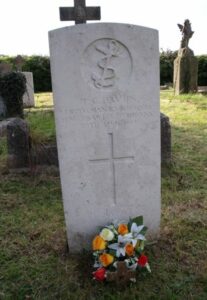
Thomas Henry Davies, Private, 60663, Welsh Regiment. Thomas was born at Jordanston Hill in 1889, the son of James and Martha Davies. He enlisted at Cardiff into the Welsh Regiment. He joined the 24th Battalion, which had been formed in 1917 by the merging of the Pembroke and Glamorgan Yeomanry, and were attached to the 231 Brigade, 74th (Yeomanry) Division. The Division had formed in Egypt in January 1917 and had fought through the Palestinian Campaign, at the Battles of Gaza and the Battle and capture of Jerusalem. Thomas was killed in action during the Third Battle of Gaza, on 27 December 1917, aged 28. He is commemorated on the Jerusalem Memorial, Israel.
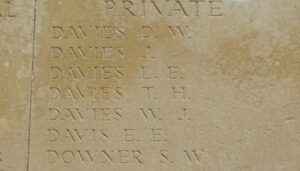
William James Edwards, Private, 91139, Machine Gun Corps. William was the son of James and Mary Edwards, of 13, Frederick Street, Neyland. He worked at Pembroke Dockyard prior to the war, and he enlisted at Pembroke on 11 December 1915 into the Army. He was posted to France on 10 August 1917, joining the 24th Company, Machine Gun Corps, which was attached to 24 Brigade, 8th Division. William saw his first action during the Battle of Langemarck in August 1917. William was only at the front for two months when he was killed in action at Ypres on 27 November 1917, aged 20. He has no known grave, and is commemorated on the Tyne Cot Memorial, Belgium.
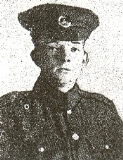
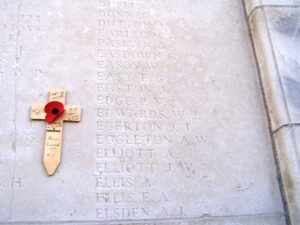
John Gilbert Elliot, Sapper, 58446, Royal Engineers. John was the son of John Henry and Annie Elliott, of Prideaux House, Hazelbeach, Neyland. He worked as a fitter prior to the war, and enlisted at Pembroke on 2 October 1914 into the 9th Welsh. He was discharged a month later as incorrigible and worthless! John re-enlisted into the Royal Engineers, and was posted to the 79th Field Company, based at the ‘E’ Training Centre. The company was attached to the 18th (Eastern) Division, which landed in Boulogne in May 1915, and didn’t see it’s first major action until July 1916 when it took part in the Battle of Albert. They then fought at the Battle of Bazentin, where they captured Trones Wood, and moved on to the Battle of Delville Wood. In October they took part in the Battle of the Ancre Heights, and captured Schwaben Redoubt, and helped capture Regina Trench. They then fought at the Battle of the Ancre, and during the subsequent Operations on the Ancre, before spending the winter on the Somme. John was wounded on the Somme and sent home for treatment, but he sadly died of his wounds on 4 February 1917, aged just 20. John is buried at Honeyborough Cemetery, Neyland.
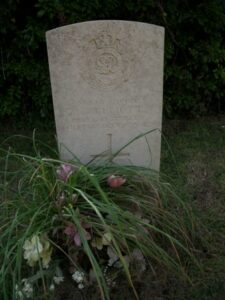
Henry James Escott, Private, 16619, Royal Irish Regiment. Henry was born in Cork, Ireland in 1899, the son of William and Emma Escott. By 1901 the family had moved to St. Davids, then by 1911 had moved again to Hazelbeach, where William was a Royal Naval Pensioner, and worked as a Writer at Pembroke Dockyard. Henry enlisted at Milford into the Army. He was posted initially to the Royal Dublin Fusiliers, but transferred to the 2nd Battalion, Royal Irish Regiment, which was attached to 188 Brigade, 63rd (Royal Naval) Division. The Division moved to France, arriving at Marseilles during May 1916 and moved to positions on the Somme, where it took part in the Battle of the Ancre, and the resulting Operations on the Ancre. In April 1917 the Division were at Arras, and fought at the Second Battle of the Scarpe, where they captured Gavrelle. They then fought at the Battle of Arleux, before moving north to Ypres, where they took part in the Second Battle of Passchendaele. Their next major action was at Cambrai, during the Action of Welch Ridge, and they were still in the area when the Germans launched their Spring Offensive, and fought at the Battle of St Quentin, and then the First Battle of Bapaume. In August, the Division took part in the Battle of Albert, which marked the beginning of the great offensive which was to end the war. They then fought at the Battle of Drocourt-Queant, and the Battle of the Canal du Nord. Henry was killed in action during the terrible fighting around the Hindenburg Line positions on 27 September 1918, aged 19. He is buried at Queant Road Cemetery, Buissy, France.
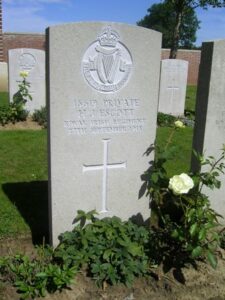
Albert Heber Evans, Private, 31413, Welsh Regiment. Albert was the son of Thomas Henry and Hester Evans, of Bungalow, Church Lakes, Neyland, and enlisted at Haverfordwest into the Welsh Regiment. He was posted to the 19th Battalion, which was the Pioneer Battalion of the 38th (Welsh) Division. The Division had landed in France during December 1915 and had spent their first winter in the trenches near Armentieres. In June they marched south to the Somme, where they were tasked with the capture of Mametz Wood. The attack on the wood began on 7 July 1916, but met with fierce resistance. The Division suffered a change in leadership before renewing the attack on 10 July, and within two days of heavy fighting, had secured the wood. The Division suffered terrible casualties at Mametz, and were taken out of the line, and moved to Ypres to rebuild. Albert was wounded at Mametz Wood, and evacuated to the Hospital at Rouen for treatment, but he sadly died there on 28 July 1916. Albert was just 19 years old, and is buried at St. Sever Cemetery, Rouen, France.
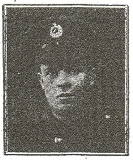
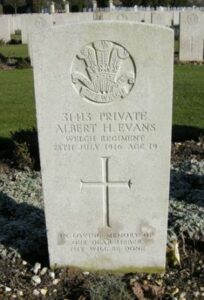
J. Galloway. This man cannot presently be identified, however a George Galloway was residing at 32, Kensington Road, Neyland and then at 48, High Street, Neyland for several years prior to the war.
Thomas George Gee, Lance Corporal, 24/1654, Northumberland Fusiliers. Thomas was born at Neyland, the son of Robert and Mary Gee. The family had moved back to their native Newcastle-on-Tyne by 1901. Thomas married in 1903, and lived with his wife, Annie Gee, at 158, Gloucester Road, Newcastle. Thomas enlisted there into the Northumberland Fusiliers, being posted to the 11th Battalion, attached to 68 Brigade, 23rd Division. Between 21 and 26 August 1915 the Division landed in Boulogne and proceeded to the Western Front, initially concentrating near Tilques. They saw their first major action at the Battle of Albert, where they captured Contalmaison, and then fought at the Battle of Bazentin, the Battle of Pozieres, the Battle of Flers-Courcelette, the Battle of Morval and the Battle of Le Transloy, where they captured Le Sars. They then moved to Ypres, which is where Thomas was killed on 5 January 1917, aged 38. He is buried at Ypres Reservoir Cemetery, Belgium.
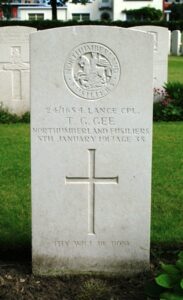
Aubrey Goodridge, Rifleman, 1935, London Regiment. Aubrey was born at Neyland in 1895, the son of Simon and Elizabeth Goodridge. By 1901 the family had moved to 184, Balmoral Road, Gillingham, Kent. Aubrey enlisted at Blackheath into the 20th Battalion, London Regiment (Blackheath and Woolwich), which was attached to 141 Brigade, 47th (2nd London) Division. The Division moved to France during March 1915, and fought at the Battle of Aubers, and the Battle of Festubert during May 1915. In September 1915 the Division fought at the Battle of Loos, and the subsequent Action of Hohenzollern Redoubt. It was still in the sector when Aubrey was killed in action on 12 February 1916. He was 21 years old, and is buried in Maroc British Cemetery, Grenay, France. Aubrey is not commemorated locally.
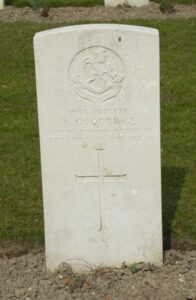
Ernest John Griffiths, Private, S/837, Queen’s Own Royal West Kent Regiment. Ernest was born at Poplar, Middlesex, the son of John and Mary Griffiths. John was originally from Burton, and had moved the family back to 86, Cambrian Road, Neyland prior to the war, where Ernest had enlisted into the Welsh Regiment. He had served his time with the Welsh in India prior to the outbreak of war, and rejoined the colours at Maidstone on 15 September 1914, joining the Royal West Kent Regiment. On 24 October Ernest was posted to their 9th Battalion, and on 10 December 1915 was posted to their 2nd Battalion, which was attached to 34 Brigade, 15th (Indian) Division, and embarked for Mesopotamia to join them. Ernest became ill, and died at Kut on 27 April 1916. He was 33 years old, and is buried at Amara War Cemetery, Iraq. Ernest is not commemorated on either memorial.
Benjamin Thomas Halliday, Rifleman, Y/631, Kings Royal Rifle Corps. Benjamin was born in Tondu in 1890, the son of Joseph Halliday, a Railway Engine Driver from Durham. Ben was a newspaper reporter prior to the war, training with The Welshman, at Carmarthen. At some time after 1911 he had enlisted into the 4th Welsh. He continued to work as a reporter prior to the war, and enlisted in London on 1 September 1914 into the King’s Royal Rifle Corps. He landed in France on 26 March 1915, and was attached to the 4th Battalion, Kings Royal Rifle Corps, which was attached to 80 Brigade, 27th Division, and had been in France since 21 December 1914. Benjamin saw his first major action in France during the Second Battle of Ypres. Benjamin was wounded in France on 11 May 1915, and was hospitalised at Versailles. He returned home for treatment, but sadly died at the 3rd General Hospital at Oxford on 30 August 1915, aged 24. His sister was by then living in Neyland, so Benjamin was brought back there for burial in Honeyborough Cemetery, Neyland. Benjamin is not commemorated locally.
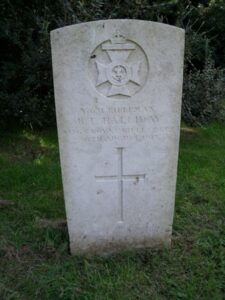
Thomas Richard Hare, Deck Hand, 691DA, Royal Naval Reserve. Thomas was born at Dover on 4 December 1877, the son of Alfred and Sarah Hare. Prior to the war he worked as a fisherman, and resided with his wife Elizabeth Hare, at 12, James Street, Neyland. Thomas worked as a Deck Hand on the trawler Amy. In August 1914 Amy was requisitioned by the War Ministry for minesweeping duties, and it was while minesweeping off Le Havre on 11 April 1917 that she struck a mine and sank with the loss of her skipper and eight ratings, including Thomas. He was 40 years old, and is commemorated on the Plymouth Naval Memorial, Devon.
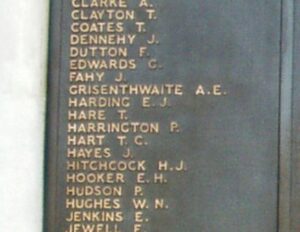
Percival Arthur Vaughan Harries, Private, 21952, Kings Shropshire Light Infantry. Percival was the son of John and Lilly Harries, of Penbryn, Hazel Bank, Neyland. He had been called up and joined the Training reserve Battalion of the Welsh Regiment, before being posted to the 1/4th Battalion, Kings Shropshire Light Infantry, which had returned from duty in Singapore, joining 56 Brigade, 19th (Western) Division in France in June 1917. The Division was by that time at Ypres, where they had taken part in the Battle of Messines. They fought on the Menin Road and at Polygon Wood, before moving up to Broodseinde, Poelcappelle and Passchendaele Village itself. In 1918 they were caught up in the German Spring Offensive near St. Quentin, where they suffered terrible casualties, and fought at the Battle of Bapaume. They moved to Ypres, but were caught up in the German attack at Messines, and at Bailleul, and Kemmel. After suffering terribly again, they moved South to the quieter French sector to rebuild, but were caught up in the German offensive on the Aisne, and fought during the Battle of the Selle, Valenciennes, the Sambre and the Passage of the Grand Honelle. Percival was wounded during the final battles of the war, and returned home for treatment. Sadly he died of his wounds in Croydon Military Hospital on 11 March 1919 aged just 20, and is buried at Honeyborough Cemetery, Neyland.
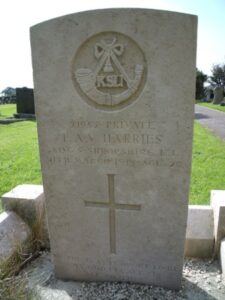
John Godfrey Wilson Victor Harris, Private, 2496, King’s Liverpool Regiment. John was born at Neyland, the son of William and Mary Harris. By 1901 the family had moved to 37, St. Domingo Grove, Liverpool. John enlisted at Liverpool on 2 September 1914 into the 5th Battalion, King’s Liverpool Regiment, which moved to France on 22 February 1915 attached to 165 Brigade, 55th (West Lancashire) Division. John was wounded within at Givenchy just weeks of moving to France, and after a brief spell in hospital rejoined his battalion at Chocques. On 24 June 1915 John was part of a fatigue party carrying out works in the trenches at Chocques. The party was returning after a hard day’s work when John tripped, and shot himself through the ankle. In the days before antiseptics, John’s injury became life threatening, and after having his leg amputated due to septic poisoning, he died of his wounds on 28 June 1915, aged 27. John is buried at Chocques Military Cemetery, France. John is not commemorated locally.
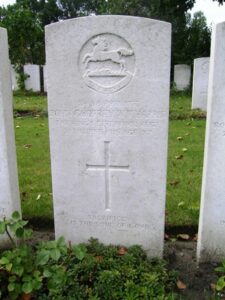
Arthur John Henderson, Engineman, 294ES, Royal Naval Reserve. Arthur was born at Steynton on 5 December 1871, the son of John and Eliza Henderson. He was a fisherman, and resided with his wife Selina, at 21, King Edward Street, Grimsby. Arthur was an engineman aboard the paddle-steamer Lady Ismay, which was a 220 foot ferry, which had sailed the Cardiff to Weston route prior to the outbreak of war. She was then requisitioned by the Admiralty, and sent to the Thames on war service as a minesweeper, but sunk near Longsand Lightship on 21 December 1915 after she struck a mine which had been laid by the German Submarine UC3. Arthur was 44 years old when he died that day, and he is commemorated on the Chatham Naval Memorial, Kent.
Thomas James Hire, Stoker 1st Class, 292159, Royal Navy. Thomas was born on 2 April 1878, the son of John and Ann Hire, of 26, Honeyboro Green, Neyland. He served throughout the war as a Stoker aboard H.M.S. Valiant, which was the smaller of the Queen Elizabeth class of Battle ships. She took part in the Battle of Jutland with all her sister ships, but escaped unharmed due in part to her superior speed. In 1916 she collided with Warspite, which put her out of action for a while, but came back into active service within a year. After the war ended she joined the Atlantic Fleet, and survived until 1947 when she was finally scrapped. Thomas served aboard her until taking ill towards the end of the war, and he died at home on 23 November 1918, aged 40. He is buried at Honeyborough Cemetery, Neyland.
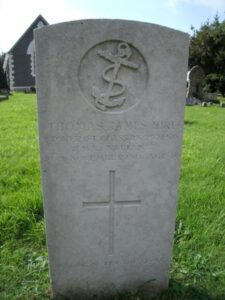
William Thomas John, Private, 54265, Welsh Regiment. William was born at Neyland, the son of Mrs. Hester John. The family later of 56, Portfield, Haverfordwest. He enlisted at Haverfordwest into the Welsh Regiment, and was posted to the 9th Battalion, attached to 58 Brigade, 19th (Western) Division. The Division assembled around Bulford during September 1914. Divisional training was completed near Tidworth, from March 1915, and the Division moved to France during July 1915, moving to positions near Loos. The Division fought during the opening attack of the Battle of Loos, and then moved to the Somme, where they took part in the second wave of the attack on Ovillers-La Boiselle on 1 July 1916, capturing the village at heavy cost, and fought through the Somme Battles of Pozieres and the Ancre in 1916. They then moved North to Ypres, taking part in the Battle of Messines, and then moved north to Ypres itself, where it fought on the Menin Road. William was killed in action here on 20 September 1917, aged only 19. He has no known grave, and so is remembered on the Tyne Cot Memorial, Belgium.
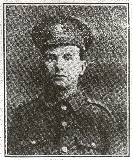
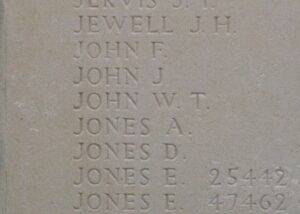
Henry Lee, Private, 285355, Welsh Regiment. Henry was born at Wrexham, but resided in Neyland prior to the war. He enlisted at Carmarthen into the Army, joining the Monmouthshire Regiment, but later transferred into the 1/6th Battalion of the Welsh Regiment, which was attached to the 1st Division as Pioneers. The Division had been one of the first to arrive in France, fighting at the Battle of Mons, and taking part in the retreat to the Marne, where the Germans were stopped. They then fought at the Aisne, and at Chivy, before being moved North to Ypres. Here they fought at the First Battle of Ypres, where they again stopped the German Offensive, before wintering in Flanders. The following year saw them in action again at the Battle of Aubers, before moving South to Loos, where they fought during the Battle of Loos, and the action at the Hohenzollern redoubt. Again they were required for a major offensive, moving South to the Somme, where they fought during the opening of the Somme Offensive at the Battle of Albert, then at Bazentin, Pozieres, Flers-Courcelette and Morval. They followed the German retreat to the Hindenburg Line in early 1917, and were then briefed for an operation on the Flanders Coast, and moved there during the Summer of 1917. While training on the coast, the Battle of Third Ypres had stalled in the mire, and the Division were recalled to Ypres, where they fought at the Second Battle of Passchendaele. After spending another Winter in Flanders, they were near Estaires when the German Spring Offensive caught them, fighting through the Battle of Estaires. Henry was killed around this time, on 16 April 1918. He is commemorated on the Loos Memorial, France. Henry is not commemorated locally.
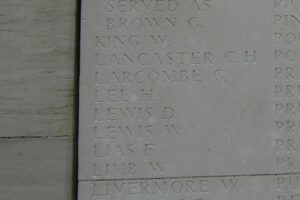
Wynford Llewellyn, Private, 4954, Pembroke Yeomanry. Wynford was born in 1898, the son of Thomas and Sarah Llewellyn, of Church Lakes, Llanstadwell. He enlisted at Haverfordwest into the Pembroke Yeomanry. The regiment formed in Tenby at the outbreak of war, joining the 1st Mounted Division. In September 1915 the front line units of the division moved to Egypt, joining the Mediterranean Expeditionary Force. The second line unit of the Pembroke Yeomanry moved to Ireland, as part of the force sent to quell the Easter Uprising. Towards the end of the Easter Risings, on 29 April 1916 Wynford was stationed near Grangegorman Hospital and had gone out with some students from the hospital to bring in some wounded civilians. He returned inside afterwards and was given a cup of tea by a nurse, before going on guard duty. Half an hour after he went back out the nurse who gave him the tea heard news that someone had been shot. He was carried into the hospital by the same students he had earlier helped and died in the arms of the nurse. Wynford was just 17 years old when he was murdered and is buried at Grangegorman Military Cemetery, in the Republic of Ireland.
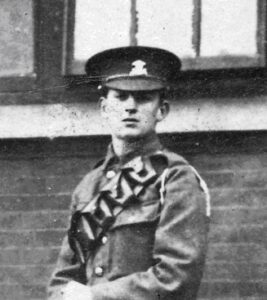
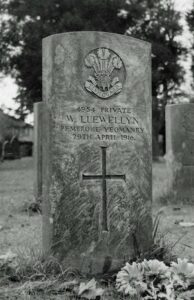
Harold Edward Moore, Private, G/118, Royal West Kent Regiment. Harold was the eldest son of Thomas E. and Elizabeth Moore, of 54, Abbott Road, Poplar, London. He enlisted at Chatham into the army and was posted to the 6th Battalion, Royal West Kent Regiment, which was attached to 37 Brigade, 12th (Eastern) Division, and landed in France in June 1915, before taking up positions near Ploegsteert. On 26 September the Division moved to Loos. Harold was wounded while his battalion was in positions near Hulloch. He died of his wounds on 3 October 1915, aged 24, and is buried at Mazingarbe Communal Cemetery, France.
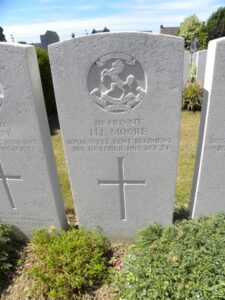
David James Nicholas, Able Seaman, Royal Navy. Little can be traced on David, but he served aboard H.M.M.L. 440, with the Royal Naval Transport Section.
James Henry Palmer, Trimmer, 2216TS, Royal Naval Reserve. James was the son of William and Margaret Palmer, of 6, West Lane, Honeyborough, Neyland, and was a fisherman prior to the war. When war broke out, the Admiralty took over the fishing fleet, and so James became a Trimmer in the Royal Naval reserve aboard the Trawler Fulmar. Fulmar was a Grimsby registered vessel, built in 1899 and taken on by the Admiralty in May, 1915. She was sunk by a mine on 17 January 1916 in the Gulf of Sollum, going down with all hands, including James. He was just 19 years old, and is commemorated on the Plymouth Naval Memorial.
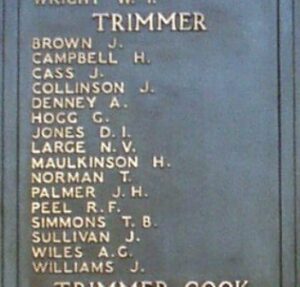
Robert James Peters, Second Engineer, Mercantile Marine. Robert was born at Garnant on 19 August 1886, the son of David and Mary Peters. His father was originally from Milford Haven, but worked for the Great Western Railway, moving the family around west Wales as he progressed in his career. Robert followed his father into the Great Western Railway, becoming an apprentice engineer at Neyland. He then worked for the Mercantile Marine, and had moved to Goodwick prior to the war, serving as Second Engineer aboard the steamship S.S. Inniscara. On 12 May 1918 Inniscarra was en route from Fishguard to Cork, carrying a general cargo, when she was torpedoed and sunk by the German submarine U-86, ten miles off Ballycottin Island, with the loss of 28 lives. Robert was 31 years old when he died that day, and is commemorated on the Tower Hill Memorial, London. Robert does not appear to be commemorated anywhere locally, but his parents are buried at Neyland.
David James Petherick, Engineman, 2485TS (Dev), Mercantile Marine. David was born on 8 June 1886, the son of David James Petherick, of Briton Ferry, Neath. He served with the Royal Naval Reserve during the war, and was posted aboard HM Trawler Bradford, an anti submarine vessel. David was married to Rose Petherick, and the family had set up home at 18, James Street, Neyland. On 26 October 1916, David was at sea aboard Bradford, which was on patrol off Cork, when she sank during a storm, with the loss of all hands. David was 30 years old, and is commemorated on the Plymouth Naval Memorial, Devon. Rose passed away in 1919.
Sidney Phillips, Deck Hand, 724DA, Royal Naval Reserve. Sidney was born on 10 April 1881, the son of Ellen Phillips, of 36, Front Street, Neyland. He had played rugby for Neyland prior to the war, and had worked aboard the Irish Ship, Great Western. Upon the outbreak of war, Sidney joined the Royal Naval Reserve, and became a member of the crew of H.M. Trawler Kirkland, a trawler which had been converted for minesweeping duties. Sidney was killed when Kirkland struck a mine in the North Sea on 20 August 1917. He was 36 years old, and is commemorated on the Plymouth Naval Memorial, Devon. Sidney’s next of kin was shown as his sister, Mrs. Lavinia Jones, 32, Charles Street, Neyland.
Ernest Clifford Plane, Private, 1782, Welsh Regiment. Ernest was born at Marcross, Glamorgan on 2 December 1898, the son of William and Margaret Plane. The family later resided at Llanelli, and then at 80, Cambrian Road, Neyland. Ernest had worked for the Great Western Railway for three years prior to the outbreak of war, and was underage when he enlisted into the 6th Battalion, Welsh Regiment. The battalion moved to France soon after the outbreak of war, and was stationed at Calais for several months on Lines of Communication, before joining the 28th Division, then in October 1915 transferred to 3 Brigade, 1st Division, at Loos. Ernest was killed in action near Loos on 30 November 1915. He was just 16 years old, and is buried at Dud Corner Cemetery, Loos, France. Ernest’s brother George was also killed, but neither are commemorated locally.
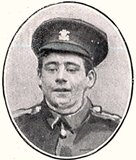
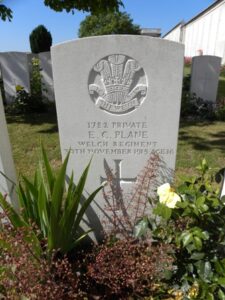
George Sidney Plane, Sapper, 9047, Royal Engineers. George was born on 21 January 1881, the son of William and Margaret Plane, of 80, Cambrian Road, Neyland. He enlisted at Andover into the Royal Engineers, and was posted to the 26th Field Company, Royal Engineers, which was attached to the 1st Division, and had been in France since the outbreak of war. After fighting through all of the major battles of the war, the Division had taken part in the great advance of 1918, and had taken part in the Battle of the Sambre just before George was killed in action, sadly just a week before the Armistice, on 4 November 1918, aged 37. He is buried at Mazinghien Communal Cemetery, France. His brother Ernest was also killed, but neither are commemorated locally.
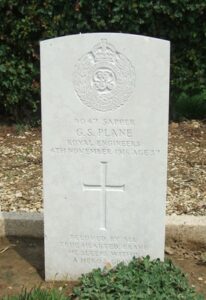
James Ivor Rees, Rifleman, R/3412, King’s Royal Rifle Corps. James was born at Llanstadwell in 1892, the son of James and Sarah Rees. His family later moved to Goodwick at some time after 1901, and James enlisted there into the army. He was posted to the 12th Battalion, King’s Royal Rifle Corps, which was attached to 60 Brigade, 20th (Light) Division. On 22 July 1915 the battalion landed in Boulogne, and moved to the Fleurbaix Sector for trench familiarisation and training. When the Battle of Loos was launched on 25 September 1915 the Division fought a diversionary attack towards Fromelles. Later that year they moved north, and fought at the Battle of Mount Sorrel alongside the Canadian Corps. They then fought through the Somme Offensive, at the Battles of Delville Wood, Guillemont, Flers-Courcelette, Morval and Le Transloy, and took part in the advance to the Hindenburg Line in March 1917. Later that year they fought at Third Ypres, at the Battles of Langemarck, the Menin Road, and Polygon Wood, before moving south in November, to take part in the Battle of Cambrai. They remained in the area between Cambrai and St. Quentin over the winter of 1917/18 and were attacked there by the German Spring Offensive of 21 March 1918, suffering heavy casualties over the coming days. James was killed in action on 29 March 1918, aged 25. He has no known grave, and is commemorated on the Pozieres Memorial, France. James is not commemorated locally.
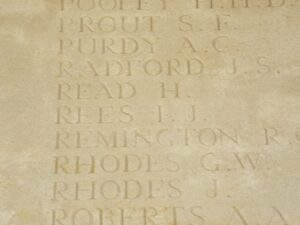
Benjamin John Richards, Carpenter Lieutenant, Royal Navy. Benjamin was the son of Thomas and Esther Richards of Neyland, and the husband of Helen Richards of 58A London Road, Portsmouth. He was an experienced sailor, having been a regular in the Royal Navy since before the Boer War, and by 1914 was a Carpenter Lieutenant aboard H.M.S. Terrible, an ancient armoured cruiser. She had seen action on the China Station, and during the Second Boer War, but was laid up afterwards, being brought back into service as a troopship at the outbreak of the Great War. Benjamin sadly died of illness at Portsmouth on 2 May 1917, aged 38. He is buried at Haslar Royal Naval Cemetery, Kent.
William Peter Johnson Roberts, Private, 42720, Machine Gun Corps. Peter was born at Neyland, the son of Peter and Lilian Roberts. The family later resided at 48 Rawson Road, Seaforth, Liverpool. Peter enlisted at Glasgow into the Highland Light Infantry, but later transferred into the 140th Company, Machine Gun Corps, attached to 140 Brigade, 47th (2nd London) Division. The Division moved to France during March 1915, and served on the Western Front throughout the war. The new designation of the Division, its Brigades and other constituent units changed from the 2nd London to 47th in mid May 1915. The Division fought at the Battle of Aubers, and the Battle of Festubert during May 1915 and in September fought at the Battle of Loos, and subsequent Action of Hohenzollern Redoubt. They were north of Arras when the Germans attacked Vimy Ridge, and then moved south to the Somme, where they fought at the Battle of Flers-Courcelette, and then at the Battle of Le Transloy, where the Division captured Eaucourt l’Abbe, and took part in Attacks on the Butte de Warlencourt. Early in 1917 the division moved north to Ypres, and it was here, soon after the move north, on 1 February 1917 that Peter was killed. He was just 19 years old, and is buried at Bedford House Cemetery, Belgium.

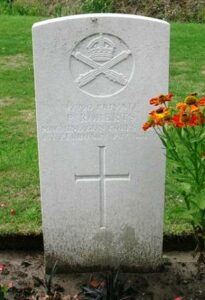
William George Roberts, Private, 35322, Kings Shropshire Light Infantry. William was born at Neyland on 7 September 1898, the son of Sydney and Sarah Roberts. He enlisted there into the Army, joining the Training Reserve Battalion. From there he was posted to the 7th Battalion, King’s Shropshire Light Infantry, which was attached to 76 Brigade, 3rd Division. The division had been in France since the outbreak of war, and had fought at most of the major battles that followed. In November 1917 the Division fought at the Battle of Cambrai, and they were in the area during March, 1918 when the German Spring Offensive swept through the British lines, fighting at the Battle of St Quentin and the First Battle of Bapaume. William was killed on the second day of the fighting, on 22 March 1918, aged 19. He has no known grave, and is commemorated on the Arras Memorial, France.
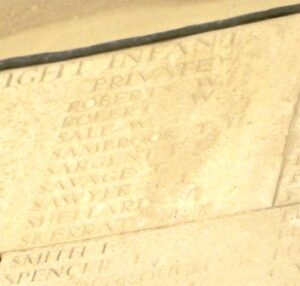
William Robinson, Private, 200343, Essex Regiment. William was born at New Milton, the son of William and Melalia Robinson. By 1911 the family had moved to 41, Parkside, Woodford Green, Essex. William enlisted at Laughton, Essex into the Essex Regiment, and was posted to the 4th Battalion, Essex Regiment. The battalion was attached to 161 Brigade, 54th (East Anglian) Division. In July 1915 the division embarked at Liverpool, for Mudros Island, and on 10 August 1915 was landed at Suvla Bay, Gallipoli. Here it remained until being evacuated in December 1915, when the entire 54th Division was withdrawn from Gallipoli, and moved to Egypt, and eventually into Palestine in early 1917. Here it fought in the successful campaign to drive the Turks from Palestine. William was killed during the First Battle of Gaza on 26 March 1917, aged 20. He is commemorated on the Jerusalem Memorial, Israel.
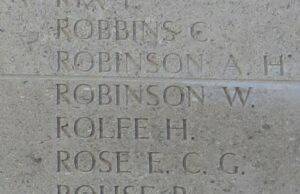
Kenneth Roy Roper, Private, PO/18905, Royal Marine Light Infantry. Kenneth was born at Dorchester on 14 September 1898, and was the son of Millie Smith (formerly Roper), of 76, Cambrian Road, Neyland. He enlisted into the Royal Marine Light Infantry on 12 September 1916, and served at HMS Colleen, the Royal Naval Depot at Queenstown in Southern Ireland. He died of pneumonia at Queenstown on 10 November 1918, aged 20. Kenneth is buried at Cobh Old Church Cemetery, the same cemetery in which many of the dead who were washed ashore after the Lusitania sinking were buried.
William James Russan, Shipwright 1st Class, 342323, Royal Navy. William was born on 8 October 1877, the son of John and Lavinia Russan. He was a pre-war regular in the Royal Navy, and had married whilst based at Queenstown, his wife Mary Ignatius Russan, residing at 11 Hawthorne Terrace, Queenstown, Co. Cork. William served aboard H.M.S. Lavender, which was a Flower Class Minesweeper, that had been launched in 1915. She was on active service when she was torpedoed and sunk in the English Channel on 5 May 1917 by UC75. William died in the sinking of the ship that day. He was 39 years old, and is commemorated on the Plymouth Naval Memorial, Devon.
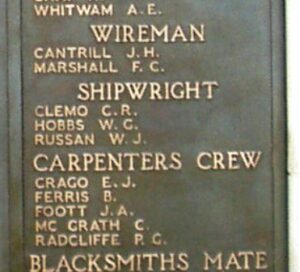
George Ernest Trevor Saunders, Sapper, 496759, Royal Engineers. George was born at Swansea in 1884, the son of Evan George Saunders and Sarah Saunders. He was the husband of Hannah Saunders, of Ioa, Whiteladies Road, Clifton, Bristol. George and Hannah resided at Neyland prior to the war, and he enlisted at Neyland into the Royal Engineers, and was posted to their 457th Field Company, attached to the 62nd Division. The Division concentrated on the Western Front by 18 January 1917, and saw their first action during the Operations on the Ancre. They then followed the German Retreat to the Hindenburg Line, before taking part in the Flanking Operations Round Bullecourt, which is where George was killed on 16 April 1917, aged 32. He is buried at Villers-Faucon Communal Cemetery, France.
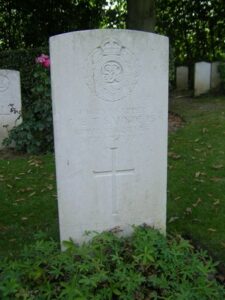
Oliver James Scurlock, Private, SE/31763, Royal Army Veterinary Corps. Oliver was the son of William Henry and Jane Scurlock, of Church Road, Hazelbeach, Neyland. Very little is known of him, but he served with the Royal Army Veterinary Corps, at No. 2 Veterinary Hospital, Longmoor. He died at Farnham, Surrey on 29 November 1918, aged just 19. Oliver is buried at Honeyborough Cemetery, Neyland. His brother William John Scurlock died in 1924 due to the effects of his wartime service, and is buried with Oliver.
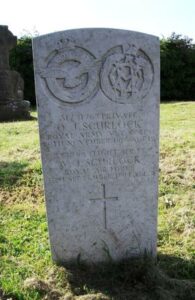
Richard Charles Scurlock, Private, 226554, Monmouthshire Regiment. Richard was born at Neyland, the son of Richard and Lettice Scurlock. Prior to the war he resided with his wife Lily Scurlock, at 71 Charles Street, Abertysswg, Cardiff. Richard enlisted at Newport on 1 September 1914 into the South Wales Borderers. Two months later he was discharged as medically unfit, but re-enlisted, and was posted to the 1st Battalion, Monmouth Regiment, which was the Pioneer Battalion to the 46th (North Midland) Division. The Division moved to France during February 1915, and saw its first action at the Hohenzollern Redoubt near Loos. The Division suffered large numbers of casualties during the attack, which was its first large-scale action. On 23 December 1915 the Division was ordered to proceed to Egypt, but after many of the units had reached Egypt, the order was countermanded and the units returned to France. Here the Division took part in the Attack on the Gommecourt Salient, which was a diversionary attack on 1 July 1916 intended to draw attention away from the main attack on the Somme, but the Division again suffered large numbers of casualties during the attack. They rested for several months at Arras, and at the end of 1916 took part in Operations on the Ancre. During March 1917 the Division followed the German Retreat to the Hindenburg Line, and then fought in the Battle of Arras, taking part in the Battle of Hill 70. They then moved to Ypres, which is where Richard was killed on 24 June 1917, aged 30. He is buried at Vlamertinghe New Military Cemetery, Belgium. Richard is not commemorated at Neyland, but at nearby Rosemarket.
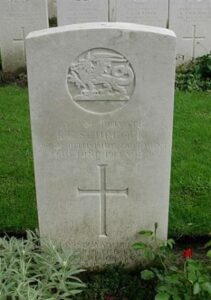
William John Scurlock, Flight Sergeant, 333064, Royal Air Force. William was the son of William Henry and Jane Scurlock, of Church Road, Hazelbeach, Neyland. He had served with the Army Veterinary Corps and the Royal Welsh Fusiliers during the Great War, and remained in the forces after the armistice, serving as a Flight Sergeant with the Royal Air Force. William died on 6 September 1924, aged 30. He is buried at Honeyborough Cemetery, Neyland. William is not commemorated locally. His brother Oliver James Scurlock died in 1918 due to effects of the war.

William John Sobey, Able Seaman, 238301, Royal Navy. William was born at Devonport on 4 December 1889, the son of William John Sobey and Matilda Marion Sobey. The family had moved to Pembroke Dock by 1901, and after William’s fathers death, moved to 11, St. Clemet’s Road, Neyland. William served as a pre-war regular aboard the Battle Cruiser H.M.S. Indefatigable. She was a powerful battlecruiser, and was attached to the 2nd Battlecruiser Squadron, under the command of Captain C. F. Sowerby. On 31 May 1916, Indefatigable became the first casualty of the Battle of Jutland, when she was hit by a salvo of 11 inch shells from S.M.S. Von der Tann. She was hit first by two shells in the “X” magazine area, blowing out her bottom and causing her to fall out of formation, sinking by the stern. Following more hits in the area of ‘A’ turret, the forward magazine exploded, and the ship sank quickly, killing all but three of her crew of 1,017. William went down with his shipmates that day. He was 26 years old, and is commemorated alongside them on the Plymouth Naval Memorial, Devon.
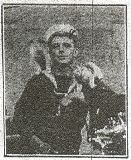
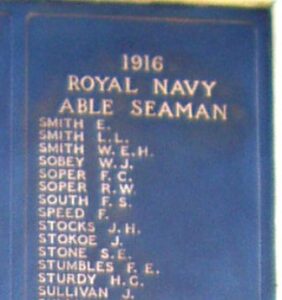
Thomas Stewart, Private, 15416, Royal Welsh Fusiliers. Thomas was the son of John and Elizabeth Stewart, of 14, Lawrenny Street, Neyland. He enlisted at Swansea into the 10th Battalion, Royal Welsh Fusiliers, which was attached to 76 Brigade, 3rd Division. One of the first Divisions to move to France, the 3rd Division remained on the Western Front throughout the war, and fought during the opening Battle of Mons, and in the epic retreat, from the Rearguard Action of Solesmes, through the Battle of Le Cateau, and down to the Marne, where the German Offensive was stopped. They followed the German withdrawal to the Hindenburg Line, where they met them in battle, and stopped the advance on Paris. The Division then moved north to Flanders, and took part in the Battle of La Bassée, and at the Battle of Messines, which were a prelude to the First Battle of Ypres. They took part in the famous Christmas Truce on 25 December 1914 and remained at Ypres throughout the winter. In 1915 the Division saw action at Bellewaarde and Hooge, and took part in the Second attack on Bellewaarde, and in 1916 fought at the Actions of the Bluff, and at the St Eloi Craters. Thomas was killed at Ypres on 17 February 1916, aged 24, and is commemorated on the Ypres (Menin Gate) Memorial, Belgium.
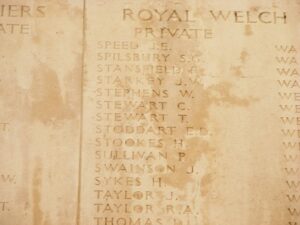
Emlyn Cyril Langham Thomas, Private, 70433, Kings Liverpool Regiment. Emlyn was the son of William and Ann Thomas, of 7, Frederick Street, Neyland. He initially served with the King’s Liverpool regiment, but after suffering from being gassed on the Western Front, he was medically downgraded, and joined the Labour Corps. Emlyn died at home as a result of being gassed, on 1 July 1921. He was 26 years old, and is buried at Honeyborough Cemetery, Neyland.
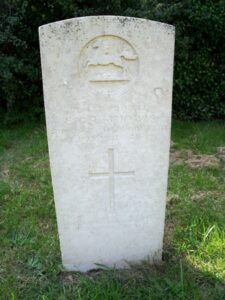
Frederick Collins Thomas, Private, 7543, Dorsetshire Regiment. Frederick was born in Middlesex in 1886, the son of William Collins Thomas and Elizabeth Jane Thomas. The family were living at 7, Grove Place, Haverfordwest by 1891, where William worked as a Solicitor’s Clerk. William worked as a Baker at Carmarthen during the time of the 1901 Census, and during 1905 enlisted as a Private with the 2nd Battalion, Dorset Regiment. By 1911 he was stationed at Wanowrie Lines, Poona, and had married a widow, Sarah Hinton, in 1910. He served with the regiment in India and Mesopotamia throughout the war, and after the armistice transferred to the 2nd Garrison Battalion, Essex Regiment, which was at Nasirabad. He remained in India after being demobilised in 1919, finding work with the Eastern Bengal State Railway, for which he had worked with as an electrician prior to enlisting in 1905. He appears to have returned to England by 1934, and died in London in 1954, aged 70. His brother George resided at Neyland, and had fruitlessly attempted to find Frederick after the war, presumably thinking him dead, hence his inclusion on the memorial.
George Tomkins, Private, 54284, Welsh Regiment. George was born at Ellesmere, Salop in 1885, the son of Thomas and Sarah Tomkins. Whilst based locally with the 4th Welsh in 1916, George married Emily Louisa Folland, of 3, Church Lakes Terrace, Neyland. He was posted to the 15th Battalion, Welsh Regiment, which was the Carmarthen Pals Battalion, attached to 114 Brigade, 38th (Welsh) Division. The Division landed in France in December 1915, and was posted to the front at Fleurbaix, where it gained valuable trench experience, before marching to the Somme in June 1916, where it fought at Mametz Wood. After a mauling at Mametz, the Division was posted to a quieter sector at Boesinghe, north of Ypres, where it was to remain for the coming fourteen months. On 30 April 1917 the 15th Welsh set out on a massive raid on the German lines at the Mortjelde Estaminet, with 7 officers and 180 men. The raid was a success, but George was killed while in the German trenches, and left behind to be buried by the Germans. After the war his body was moved, and he now lies in Perth Cemetery (China Wall), Belgium. He was 21 years old.
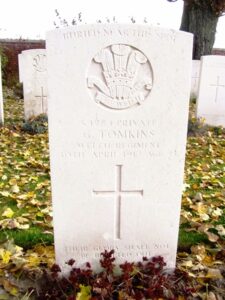
Joseph Bowen Vaughan, Able Seaman, 196437, Royal Navy. Joseph was the son of William and Mary Vaughan, of 15, Frederick Street, Neyland, and served as a regular in the Royal Navy, aboard the Minotaur Class Armoured Cruiser, H.M.S. Defence. Defence had been built at the nearby Pembroke Dockyard, and was launched in 1907. At the outbreak of war she was in the Mediterranean, and took part in the pursuit of the Goeben and Breslau. She was the flagship of Rear Admiral Sir Robert Arbuthnot at the Battle of Jutland on 31 May, 1916 when she was hit by a salvo from nearby German Battlecruisers, and blew up and sank immediately, taking with her the entire complement of 903 men. Joseph was 33 years old when he died that day, and is commemorated alongside his former ship-mates on the Plymouth Naval Memorial, Devon.
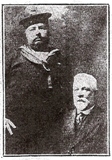
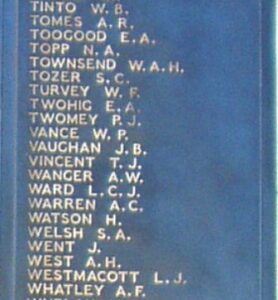
Charles Edward Warlow, Leading Carpenter’s Crew, 345941, Royal Navy. Charles was born at Angle in 1882, the son of William and Lettice Warlow. The family resided at Neyland from 1891 onwards. Charles was a regular in the Royal Navy, serving aboard the Battlecruiser H.M.S. Invincible. She was the first Battlecruiser ever built, and was launched in 1907. At the beginning of the war she took part in the Battle of Heligoland Bight, and was then sent to the South Atlantic, where she took part in the Battle of the Falklands. At the Battle of Jutland on 31 May, 1916 she was the Flagship of the 3rd Battlecruiser Squadron, where she was struck by a shell from Lutzow which penetrated her Q-Turret, igniting a flash down to the magazine, which blew her apart. Only six men out of a crew of 1,021 survived the explosion. Charles Edward Warlow was one of the dead. He was 33 years old, and is commemorated on the Portsmouth Naval Memorial, Hampshire.
Arthur Webb, Corporal, 30859, Royal Garrison Artillery. Arthur was the son of John and Eliza Webb, of Norfolk. He had served with the Norfolk Regiment, and joined the Royal Garrison Artillery in 1909. Arthur served in Pembrokeshire prior to the war with the 22nd Battery, Royal Garrison Artillery. On 27 August 1914 he was posted to the 4th Siege Battery, Royal Garrison Artillery, which moved to France in September 1914, moving to positions in Flanders, near Neuve Chappelle. Arthur was killed while his battery was providing artillery support for the Battle of Festubert on 22 May 1915, aged 29. He was originally buried on the battlefield, but after the war Arthur’s grave was exhumed, and he was buried at Vieille-Chapelle New Military Cemetery, Lacouture, France.
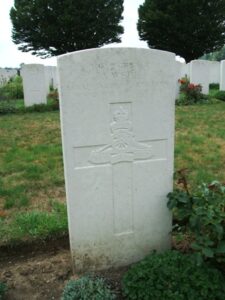
John Williams, Second Engineer, Mercantile Marine. John was born at Neyland in 1890, and was married prior to the war. He resided with his wife at 1, Ivy Grove, Hull, where he worked as Second Engineer aboard the Steam Trawler Titania, which was registered at Hull. She had been bought by a consortium from Neyland, so John had joined the crew of her while she worked at Milford between 1906 and 1909. She was sold in May 1909, returning to Hull. On 11 May 1915, Titania was captured by a German torpedo boat. Records show that her crew were made prisoners, but John died that day. He was 25 years old, and is commemorated on the Tower Hill Memorial, London. John is not commemorated locally.
Edwin Frank Wood, Private, 67459, Cheshire Regiment. Edwin was the son of Robert and Mary Isabella Wood, of 41, Charles Street, Neyland. He had worked in the mines at Pantyffynon early in the war, and enlisted at Llandeilo into the army on 11 July 1917. Edwin served with the 62nd Training Reserve Battalion, and on 8 April 1918 was posted to the 11th Battalion, Cheshire Regiment, which was part of 75 Brigade, 25th Division. The Division had been in France since 26 September 1915. Edwin joined up with his new unit in Flanders, where it held positions at Ploegsteert, rebuilding ater heavy casualties on the Somme. However, on 9 April 1918 the Germans launched an offensive on the Lys, and the Division was caught up in the terrible fighting here, at the Battles of Estaires, Bailleul, Messines and Kemmel. On 9 May the Division moved to Fismes, 20 miles SE of Soissons in the Champagne, to give it a chance to rest and rebuild again. However, on 26 May they took up positions south of the Aisne, to guard against a predicted German Offensive. On 27 May the attack hit them, and during the coming days the Division was virtually annihilated. Edwin was captured during this period, and was sent to a Prisoner of War Camp in Poland. Sadly he became ill and died there of meningitis on 4 November 1918, aged 19. Edwin is buried at Poznan Old Garrison Cemetery, Poland. Many thanks to Peter Bennett for the photograph.
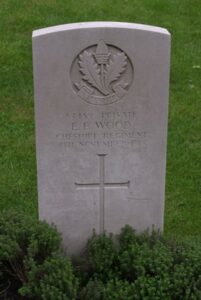
World War Two, 1939-1945
William George Aldous, Skipper, Fishing Fleet. William was born at Syleham, Suffolk on 26 December 1895, the son of William and Betsy Aldous. He served in the Fishing Fleet aboard the Fishing Vessel Exeter, a Lowestoft registered trawler. Sydney drowned when Exeter was lost at sea on 29 March 1941. He was 46 years old, and is commemorated on the Tower Hill Memorial, London.
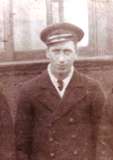
Philip James Allen, Engineman, LT/265 E.U., Royal Naval Reserve (Patrol Service). Philip was born in Cardiff on 4 January 1899, the son of William and Anne Allen. By 1911 the family had moved to Steynton, and Philip had enlisted at Milford into the Royal Naval Volunteer Reserve. He married Mary Ann Bowen, of Neyland in 1923, but Mary died in 1928, and in 1933 Philip married Elsie M Picton. During WW2 he served with the Royal Naval Patrol Service aboard HM Trawler Lord Inchcape, which was a Hull Trawler, taken over by the Admiralty in August 1939. She was sunk on 25 October 1940 after hitting a mine, but was raised and repaired, and saw further service during the war on anti-submarine duties and minesweeping. Philip died on active service at Falmouth on 20 August 1943. He was 44 years old, and is buried at Falmouth Cemetery, Cornwall.
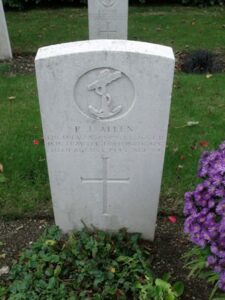
Leonard Hubert Barnard, Serjeant, 837988, Royal Welch Fusiliers. Leonard was the son of William Frederick and Florence Barnard of Milford, and the husband of Margaret Barnard, of Neyland. He served with the 4th Battalion, Royal Welch Fusiliers, which was attached to the 53rd (Welsh) Division. The Battalion had spent most of the war on home service, but landed in Normandy at the end of June 1944 as part of the reinforcing troops. During the coming weeks, the Welsh Division fought several actions during the break-out of the Normandy Beachhead, and Leonard was killed here on 19 July 1944. He was 29 years old, and is buried at Banneville-La-Campagne War Cemetery, France.
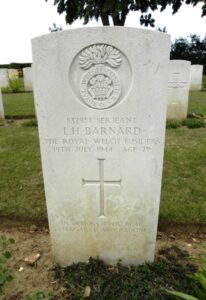
Sydney Beare, Cook, Fishing Fleet. Sydney was born on 26 October 1884, the son of Robert and Bertha Beare of Gorleston. He married Caroline Maud Shreeve, of Yarmouth in 1904. He had served during WW1 with the Royal Naval Reserve, and the family had moved to Neyland at some time, where Sydney became Cook aboard the Fishing Vessel Exeter, a Lowestoft registered trawler. He was 60 years old when Exeter was sunk by German aircraft on 29 March 1941, and is commemorated on the Tower Hill Memorial, London. Caroline died at Neyland in 1951.
William James Boast, Chief Engineer, Fishing Fleet. William was born on 5 June 1881, the son of William and Mary Ann Boast, of Yarmouth. He married Sarah Susannah Willgrass at Yarmouth in 1903, and by 1910 the couple had moved to 45, Great North Road, Milford Haven. He had served with the Royal Naval Reserve during WW1, and was mentioned in despatches on 27 June 1917 as well as being awarded the Distinguished Service Medal on 31 December 1917. He lived at Neyland after the war, and his wife Sarah died there in 1933. During WW2 William served as Chief Engineer of the Fishing Vessel Charmouth. On 14 November 1946 William was one of nine men killed when a mine blew up in the ships nets after being snagged. William was 65 years old and is commemorated on the Tower Hill Memorial, London. William’s body was later reported to have been brought to Milford Haven for burial.
Richard Job Thomas Brown, Flying Officer (Observer), 120912, Royal Air Force. Richard was the son of Joseph Harold Brown and Lucy Elizabeth Brown (nee Thomas) of Neyland, and the husband of Ethel Brown, of Chiswick, Middlesex. He served as an Observer with 39 Squadron, Royal Air Force, which was equipped with the Bristol Beaufort, in an anti-shipping role, flying from Malta. Richard was killed when his aircraft was brought down over Italy on 30 November 1942. He was 26 years old, and is buried at Catania War Cemetery, Sicily.
James Cecil Cole, Deck Hand, Fishing Fleet. James was born in 1909, the son of James Thomas and Elizabeth Cole, of 113, High Street, Neyland. He married Florence A. Owen of Hafod, Swansea in 1937, and worked aboard the Swansea registered Fishing Vessel Caerphilly Castle. James died when Caerphilly Castle was sunk by enemy aircraft on 27 January 1941. He was 31 years old, and is commemorated on the Tower Hill Memorial, London.
J. H. Collins. Cannot be positively identified.
William Henry Dunn, Private, 4032741, The King’s Shropshire Light Infantry. William was the son of Albert John and Beatrice Dunn, of Neyland. He served with the 1st Battalion, King’s Shropshire Light Infantry, which was based on the Maginot Line at the outbreak of war, taking part in the retreat to Dunkirk. After evacuation, the battalion was rebuilt, and moved to North Africa. They fought in the Western Desert, before taking part in the invasion of Sicily and Italy in 1943. William was killed in Italy on 24 April 1943. He was 27 years old, and is buried at Massicault War Cemetery, Italy.
Gwynne James Edwards, Craftsman, 7625460, Royal Electrical And Mechanical Engineers. Gwynne was the son of Howard G. Edwards and May A. Edwards, of Neyland. He had served throughout the war with the Royal Electrical and Mechanical Engineers. Gwynne married Christine Emile Whittow, of Neyland in 1945. Gwynne died at Haverfordwest on 18 November 1946, aged 29, and is buried at Honeyborough Cemetery, Neyland. Christine never remarried, and died in 2005. Gwynne does not seem to be commemorated locally.
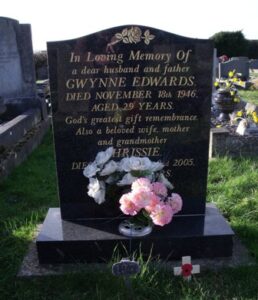
M. Evans. Cannot be positively identified.
Benjamin Griffiths, Chief Engineer, Fishing Fleet. Benjamin was the son of Thomas and Elizabeth Griffiths, of 1, Water Street, Honeyborough, Neyland. He served aboard the Fishing Vessel Exeter, a Lowestoft registered trawler. He was 50 years old when Exeter was lost at sea after being attacked by enemy aircraft on 29 March 1941, and is commemorated on the Tower Hill Memorial, London.
George Alfred Hollox, Lance Serjeant, 6457757, Royal Norfolk Regiment. George was the son of James and Laura Hollox, of London. He married Lillias Merriman Eynon of Neyland in 1941. He served with the 1st Battalion, Royal Norfolk Regiment, which formed part of the initial landings on D-Day, as part of 185 Brigade, 3rd Infantry Division. George was killed in action on D-Day, 6 June 1944. He was 35 years old, and is buried at Bayeux War Cemetery, France.
Leslie Victor Holmes, Signalman, 14206519, Royal Corps Of Signals. Leslie was the son of Albert and Melinda Jane Holmes, of Johnston. Little is known of his war service, except that he served with the Royal Corps of Signals during the war. Leslie died on active service on 2 September 1942, and is buried at Honeyborough Cemetery, Neyland, He was just 19 years old.
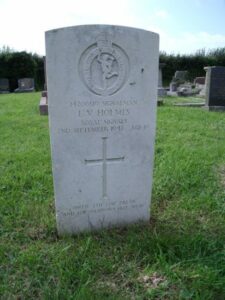
Albert Leonard John, Corporal, 3969337, South Staffordshire Regiment. Albert was the son of Albert Victor and Jennette John of Neyland, and the Husband of Florence Harries John, of Pembroke Dock. He served with the 1st Battalion, South Staffordshire Regiment, which fought in the Burma campaign. Albert died in Burma on 23 June 1944. He was 27 years old, and is buried at Taukkyan War Cemetery, Myanmar.
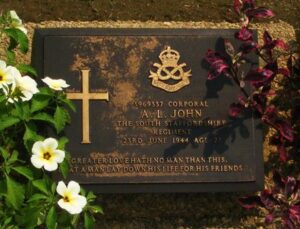
Gilbert John, Private, 13013816, Pioneer Corps. Gilbert was the son of Thomas R. John and Mary E. John, of 26, Lawrenny Street, Neyland. He had served with the South Wales Borderers during WW1. He married Gertrude Devonald at Swansea in 1924, and the couple lived at Neyland. He served during WW2 with the Auxiliary Militia, Pioneer Corps. No more is known, but Gilbert died on 3 October 1940, aged 41, and is buried at Honeyborough Cemetery, Neyland.
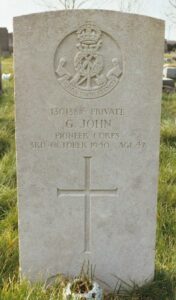
David John Johns, Flying Officer, 202780, Royal Air Force Volunteer Reserve. David was the son of David John and Emily Johns, and the husband of Nancy Johns, of Neyland. He was commissioned as a Flying Officer from Flight Sergeant on 14 March 1946 and served as a Pilot with 511 Squadron, Royal Air Force, which was a specialist long range unit, equipped with the Avro York, and flew from Britain to India as a Trooping flight, later taking part in the Berlin Airlift as part of Transport Command. David was killed during a crash on 6 October 1946 while flying aboard Avro York I, Serial MW125 which crashed about 100 miles west of Penang, with the loss of 21 lives. He was 28 years old, and is commemorated on the Runnymede Memorial, Surrey.
Wilfred Johnson, Pilot Officer (U/T), J/23528, Royal Canadian Air Force. Wilfred was the son of Edward and May Johnson, of Institute House, Neyland. The family emigrated to Canada at some time, and lived at Hamilton, Ontario. Wilfred served with the Royal Canadian Air Force, and was training as a pilot when he was killed on 13 July 1943, aged 20. He has no known grave and is commemorated on the Ottawa Memorial, Canada.
Ronald David Johnstone, MC, Captain, 219944, Royal Armoured Corps. Ronald was the son of Thomas White Johnstone and Annie Johnstone of Neyland. He married Norma Cornelius, of Sketty, Swansea in 1942. He had gained his B.A. with Honours (Cantab.) prior to the war, and was commissioned on 25 August 1941 into the 2nd Lothians and Border Horse, Royal Armoured Corps, which moved to North Africa in 1942. Ronald was awarded the Military Cross, for gallant service in North Africa, which was published in the London Gazette of 23 September 1943. By then the Allies had invaded Italy, and were driving towards Rome. Ronald was killed in action in Italy, during a tank battle against the Hermann Goering Panzer Division on 8 June 1944. He was 25 years old, and is buried at Bolsena War Cemetery, Italy.
Aubrey Thomas Grenville Jones, Sergeant (Flight Engineer), 571686, Royal Air Force. Aubrey was born at Neyland in 1921, the son of Margaret Jones (nee Reynolds). He was educated at Pembroke Dock County School, prior to joining the Royal Air Force in 1937. Aubrey became a Flight Engineer with 460 RAAF Squadron, which flew the Avro Lancaster. On 28 April 1944, he was a member of the crew of Lancaster LL-906, which was on a mission from RAF Binbrook for Friedrichshafen, when it was intercepted and shot down by a German Night Fighter. Aubrey was among seven men killed aboard the Lancaster when it crashed in France. He was 23 years old, and is buried in a collective grave at Appenwihr Churchyard, France.
Frederick James Jones, Private, 14578536, The South Wales Borderers. Frederick was the son of Thomas Llewellyn Jones and Sarah Jones, of Neyland. He served with the 2nd Battalion, South Wales Borderers, which was fought in Norway in 1940 as part of the 24th Guards Brigade. The battalion had the honour of being the only Welsh battalion to land on the Normandy beaches on D-Day, 6 June 1944, attached to the 50th (Northumbrian) Division. Frederick was killed three days into the campaign, on 9 June 1944. He was 19 years old, and is buried at Ryes War Cemetery, Bazenville, France. Many thanks to Shirley Thomas for the photograph.
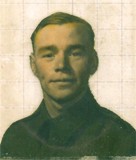
Frederick William Benjamin Jones, Stoker 1st Class, D/KX 96289, Royal Navy. Frederick was the son of William J. Jones and Elsie J. Jones (nee Underwood), of Neyland, and served with the Royal aboard HMS Acasta. She was an A-Class destroyer, which had been commissioned in 1929. She was sunk on 8 June 1940 in action against the German warships Scharnhorst and Gneisenau, while escorting the aircraft carrier Glorious, which was returning from Norway. Frederick was 20 years old when he died that day, and he is commemorated on the Plymouth Naval Memorial, Devon.
Raymond Evan Jones, Lance Corporal, 3969502, Royal Electrical And Mechanical Engineers. Raymond was the son of Evan and Lavinia Jones, and the husband of Catherine Sarah Ann Jones, of Neyland. He served in the North African campaign with the Royal Electrical and Mechanical Engineers, before taking part in the invasion of Sicily. Raymond died in Italy on 18 February 1944. He was 29 years old, and is buried at Anzio War Cemetery, Italy.
Alfred Champion Lawton, Trooper, G/544, Royal Canadian Armoured Corps. Alfred was born in Richibucto, Kent County, New Brunswick on 21 September 1919, the son of Herbert Lawton and Edith Nellie Lawton (nee Jones). His father was from Lancashire, and his mother from Neyland, but had migrated to Canada some years prior to the outbreak of the Great War. Alfred worked on the family farm prior to enlisting into the Canadian Army on 26 May 1941 and was posted to the 8th Princess Louise’s (New Brunswick) Hussars, an infantry unit which had been converted into an armoured unit as part of the Royal Canadian Armoured Corps. The regiment embarked for Britain on 9 October 1941 and trained intensively before being shipped to the Mediterranean and landed in Italy on 19 December 1943 as a unit of the 5th Armoured Brigade, 5th Canadian Armoured Division. The regiment saw heavy fighting over the coming months, fighting in the Liri Valley. On 24 May 1944 the regiment received orders to pass through the breach in the Hitler Line and to cross the Melfa river, before establishing a bridgehead on the west bank before continuing to advance. The river was crossed under heavy fire the following day and the remainder of the ensuing days was spent under intense pressure from the German defenders whilst attempting to break through. Alfred was killed in action during another day of intense fighting here, on 27 May 1944. The 23-year-old was originally buried on the battlefield, but in January 1945 his grave was exhumed, together with many others, and re-interred in Cassino War Cemetery, Italy.
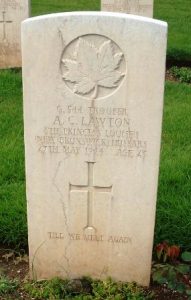
W. T. Lewis. Cannot be positively identified.
Arthur James Clement Mathias, Private, 4195858, The Monmouthshire Regiment. Arthur was the son of Frederick Clement Mathias, and of Martha Ann Mathias, of Neyland, and served with the 3rd Battalion, Monmouthshire Regiment. The battalion landed on Normandy as part of the 53rd (Welsh) Division in June 1944, and took part in the break out from Normandy. Arthur was killed in Normandy on 18 July 1944. He was 25 years old, and is commemorated on the Bayeux Memorial, France.
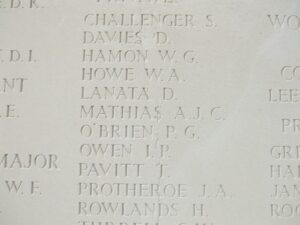
Ronald Wilfred McCormick, Drummer, 4186139, The West Yorkshire Regt (The Prince Of Wales’ Own). Ronald was the son of Florence Ann McCormick, and served with the 1st Battalion, West Yorkshire Regiment. The battalion served in the Far East, taking part in jungle warfare against the Japanese. Ronald was killed in Burma on 7 March 1942. He was 31 years old, and is commemorated on the Rangoon Memorial, Myanmar. The photograph below has been kindly supplied by Tony Beck.
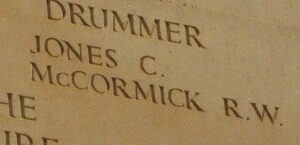
Leslie Llewellyn Nicholas, Flight Sergeant (Navigator), 1652501, Royal Air Force. Leslie was born on 23 November 1922, the son of William Nicholas and Caroline Letitia Nicholas (nee Davies), of 13, Stratford Road, Neyland. He married Phyllis Mary Kelly of Neyland in 1944. Leslie enlisted into the Royal Air Force and after qualifying as a Navigator was posted to 21 Squadron, Royal Air Force. The squadron was an elite unit, equipped with the fighter-bomber version of the De Havilland Mosquito. In February 1945, 21 Squadron were based at Rosierre en Santerre, near Amiens. On 27 February 1945 Leslie was Navigator in Mosquito VI NS990, flown by Pilot Officer A. C. Adams, when their aircraft was shot down and crashed near Bollersen, Niedersachsen, killing both men. Leslie and his pilot were initially buried at the Communal cemetery at Bergen, but have since been moved to Hanover War Cemetery, Germany. Leslie was 22 years old.
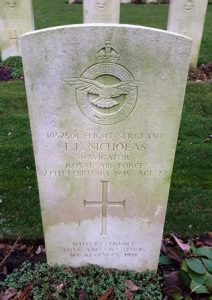
David Edward Ralph, Able Seaman, D/JX 419482, Royal Navy. David was the son of Edward Lawson Ralph and Minnie Ralph, of Jordanston. He served with the Royal Navy aboard H.M.L.C.T. 2073, a specialised Tank Landing Craft, and had taken part in the D-Day landings of 6 June 1944. David died on active service on 22 June 1945, after drowning in an accident off the south coast. He was 20 years old, and is buried at Honeyborough Cemetery, Neyland.
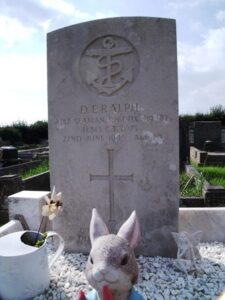
Hubert Stanley Rees, Volunteer, British Army Aid Group. Hubert was the son of William Henry and Emma Rees, of Neyland, and the husband of Jean Rees, of Tayport, Fife. He served in the Far East with the British Army Aid Group, which was a specialist group, also named MI9, which was created to assist in the escape of Allied POWs from Japanese camps. Hubert was unfortunately caught by the Japanese, and was executed on 29 October 1943 at Hong Kong. He was 43 years old, and is buried at Stanley Military Cemetery, Hong Kong.
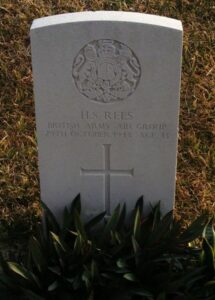
Thomas Reginald Frederick Roch, Sergeant (Observer), 921751, Royal Air Force Volunteer Reserve. Thomas was the son of Thomas H. Roch and Edith Maud Roch (nee Callan) of Waterstone. He served as an Observer with the Royal Air Force and was attached to25 OTU, based in Cambridgeshire. On 10 September 1941 Thomas was flying aboard Wellington R1767 when it crashed during a training flight in Cambridgeshire, killing all its crew. Thomas was 21 years old when he was killed that day, and is buried at Honeyborough Cemetery, Neyland.
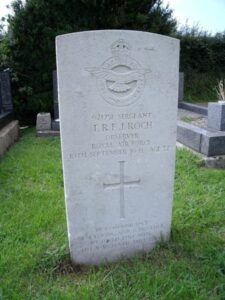
William John Cephas Rouse, Lieutenant, Royal Naval Volunteer Reserve. William was the son of William and Katherine Rouse, of Neyland and the Husband of Mary Rouse (nee Owens), of Hakin. He had studied for his BSc at London prior to the war, before being commissioned into the Royal Naval Volunteer Reserve. He was posted to the Royal Navy Base HMS Spurwing, which was a Royal Naval base at Sierra Leone, which had a Royal Naval Air Service runway near Freetown. William was killed in a road accident in Sierra Leone on 15 February 1944. He was 33 years old, and is buried at Freetown (King Tom) Cemetery, Sierra Leone.
Edward Albert Stolliday, Engineman, LT/X 421EU, Royal Naval Reserve (Patrol Service). Edward was the husband of Dora E. Stolliday (nee Evans), of Llanelly. He served with the Royal Naval Patrol Service aboard HM Trawler Lord Stamp. She was taken over by the Admiralty in August 1939, and used for minesweeping and anti-submarine duties. Edward died when Lord Stamp struck a mine in the English Channel on 14 October 1940. He is commemorated on the Lowestoft Naval Memorial, Suffolk.
William Henry Thomas, Fusilier, 4196954, The Royal Welch Fusiliers. William was the son of John Henry and Ann Thomas, and the husband of Dorothy Catherine Thomas, of Neyland. He served with the 1st Battalion, Royal Welsh Fusiliers in the Far East, and was killed in action in Burma on 25 February 1943. William was 24 years old, and is buried at Taukkyan War Cemetery, Myanmar.
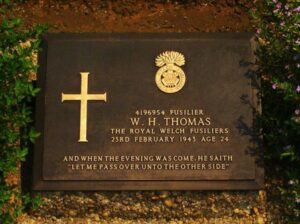
William Henry Thomas, MID, Seaman, LT/JX 186620, Royal Naval Patrol Service. William was the son of Frederick and Lilian Thomas, of Milford Haven. He married Florence May Vaughan of Neyland in 1939. He served with the Royal Naval Patrol Service aboard HM Trawler Argyllshire. She had been hired by the Admiralty in September 1939 and converted for anti-submarine duties, joining the 11th Anti Submarine Striking Group. She took part in the Norwegian campaign in April/May 1940 and then the evacuation of Dunkirk. William died when Argyllshire was sunk by a torpedo from a German E-boat off Dunkirk on 1 June 1940. He was 23 years old, and is commemorated on the Lowestoft Naval Memorial, Suffolk. William was Mentioned in Despatches for Norway.
Ernest Charles Underwood, Engineman, LT/X 5919ES, Royal Naval Reserve. Ernest was born on 19 July 1907, the son of Benjamin and Annie Underwood, of 21, James Street, Neyland. He married Eveline M. Gould in 1930. He served with the Royal Naval Reserve aboard HM Trawler Fleming. She had been hired for minesweeping duties in August 1939. Ernest died when Fleming was sunk by a German air attack in the Thames Estuary on 24 July 1940, aged 33. He is commemorated on the Lowestoft Naval Memorial, Suffolk.
Post World War Two Casualties
John Richard William Mathias, Private, 22459549, Welch Regiment. John was born on 8 November 1932. He enlisted after the Second World War into the Welch Regiment, and embarked with the 1st Welch for Korea on 19 September 1941. On 12 November, the Welch moved up to Chongdong-Ni and relieved the Gloucesters. The battalion remained in Korea until 31 October 1952, and took part in heavy fighting there. John was evacuated wounded from Korea, and died in Japan on 28 July 1952. He was 19 years old, and is buried at Yokohama British Commonwealth Cemetery, Japan.
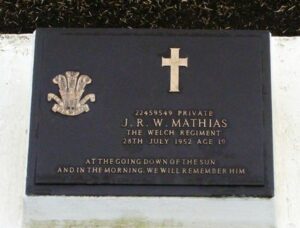
World War Two Civilian Air Raid Casualties
Neyland was scene to a terrible tragedy on 11 June 1941 when a German bomber dropped its deadly cargo on the town and destroyed Kensington House, Hazelbeack, killing four members of the same family. All four women were buried following a moving ceremony at Honeyborough Cemetery.
Miss Elvira Margaret May Evans. Elvira was the daughter of Margaret and of the late William Evans, and of Margaret Evans, of Kensington House, Hazelbeach, Llanstadwell. She was one of four members of her family killed during an Air Raid on 11 June 1941. She was 46 years old and is buried in Honeyborough Cemetery.
Mrs. Margaret Evans (nee Richards). Margaret was the widow of William Evans, and the mother of Elvira Evans, of Kensington House, Hazelbeach, Llanstadwell. She was the eldest of the four members of her family killed during an Air Raid on 11 June 1941. She was 80 years old and is buried in Honeyborough Cemetery.
Miss Margaret Mary Griffiths. Margaret was the daughter of George H. Griffiths, and of Esther Muriel Griffiths. She died with her mother, grandmother and aunt at her grandmother’s home, Kensington House, Hazelbeach, Llanstadwell during an Air Raid on 11 June 1941. She was 17 years old and is buried in Honeyborough Cemetery.
Mrs. Esther Muriel Griffiths (nee Evans). Esther was the daughter of the late William Evans and of Margaret Evans, of Kensington House, Hazelbeach, Llanstadwell. She had married George H. Griffiths, of Neyland in 1923, and the couple had a daughter, Margaret. She was killed along with her daughter Margaret, mother and sister Elvira at Kensington House, Hazelbeach, Llanstadwell during an Air Raid on 11 June 1941. She was 44 years old and is buried in Honeyborough Cemetery.